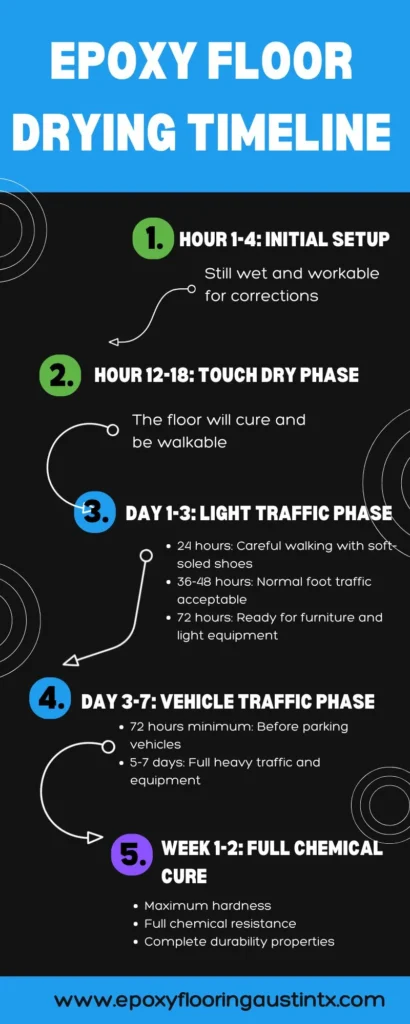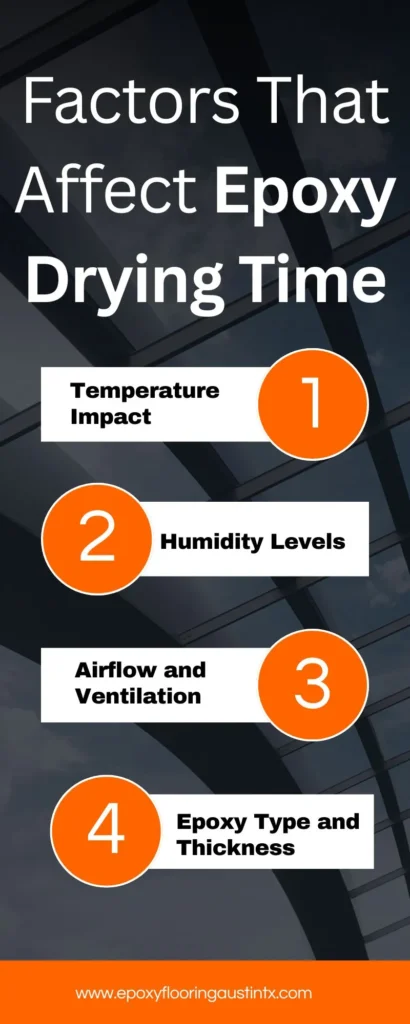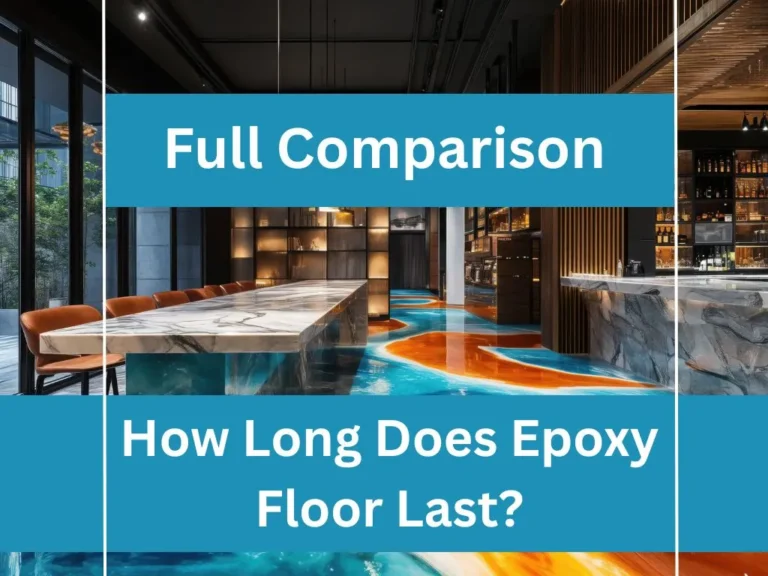How Long Does Epoxy Flooring Take to Dry? A Complete Guide
Epoxy floors take 12–24 hours to dry for light use, 48–72 hours for heavy stuff, and 7–10 days for max strength. With Austin’s heat and humidity, smart prep and ventilation are your MVPs. Whether you’re DIYing or calling in pros like Epoxy Flooring Austin, TX, you’re now armed to nail it.
Hey Austin folks! Ready to give your garage or patio that sleek, glossy epoxy glow? Whether you’re sprucing up a South Congress loft or a Round Rock workshop, one big question looms: How long does epoxy floor take to dry? With Austin’s wild weather—blazing summers, humid evenings, and those rare chilly mornings—the wait can feel like forever.

But don’t sweat it! This 2025 guide breaks it all down, tailored for our Central Texas vibe. We’ll cover dry time vs. cure time, the science behind it, what slows it down, and Austin-specific tips to get your floor ready faster. Plus, we’ve got local pros to call if DIY isn’t your jam. Let’s dive in and get that floor game-day ready!
Note: You can find this guide helpful, if you’re also struggling that is epoxy flooring good for your home.
How Long Does Epoxy Flooring Take to Dry?
Here’s what you can expect for standard epoxy floor installations:
- Walk-on time: 12-24 hours
- Light foot traffic: 24-36 hours
- Vehicle traffic: 72 hours (3 days)
- Full chemical cure: 7-14 days
- Maximum durability: 28-30 days
Note: These timelines can vary significantly based on temperature, humidity, and epoxy type.
The Science Behind Epoxy Floor Drying: Dry Time vs. Cure Time
Understanding the distinction between “dry time” and “cure time” is fundamental to properly planning your epoxy flooring project. Many homeowners confuse these terms, leading to premature use and compromised results.
What Is “Dry Time”?
Dry time refers to the surface-level process where the epoxy feels dry to the touch. This occurs through:
Solvent Evaporation Process:
- Water-based epoxies: Water molecules evaporate first
- Solvent-based systems: Organic solvents dissipate into the air
- 100% solids epoxy: No solvents to evaporate (fastest surface drying)
Scientific Process: During the dry time phase, the epoxy undergoes physical changes rather than chemical ones. The surface becomes tack-free as volatile components escape, but the molecular structure isn’t fully developed. Think of it like a wet paint that feels dry but hasn’t reached its final hardness.
What Is “Cure Time”?
Cure time involves the complete chemical transformation that gives epoxy its legendary durability. This is a thermosetting process where:
Cross-Linking Chemistry:
- Initiation: Epoxy resin molecules react with the hardener (catalyst)
- Propagation: Long polymer chains begin forming
- Termination: A Complete cross-linked network develops
- Full Cure: Maximum molecular density achieved
The Exothermic Reaction: As epoxy cures, it generates heat through chemical reactions. This is why thick applications cure faster initially – the heat accelerates the cross-linking process. However, this same heat can cause problems if not properly managed.
Molecular Structure Development:
- 0-24 hours: Primary cross-linking (60-70% strength)
- 24-72 hours: Secondary bonding (85-90% strength)
- 7-14 days: Complete molecular matrix (95-98% strength)
- 28-30 days: Maximum chemical and physical properties (100% strength)
Why This Distinction Matters
Real-World Implications:
- A floor that’s “dry” at 18 hours might only have 65% of its final strength.
- Premature loading can cause permanent molecular damage.
- Temperature and humidity have a direct impact on the rate of chemical reactions, not only on the process of evaporation.
Detailed Epoxy Floor Drying Timeline

Hour 1-4: Initial Setup
- 0-20 minutes: Workable mixing time
- 1-4 hours: Surface begins to thicken
- Status: Still wet and workable for corrections
Hour 12-18: Touch Dry Phase
If you use 100% solids epoxy, the floor will cure and be walkable in approximately 12 to 18 hours.
However, this varies by:
- Temperature conditions
- Epoxy type and thickness
- Humidity levels
Day 1-3: Light Traffic Phase
Generally, you should wait for at least 24 to 72 hours before allowing regular foot traffic on the epoxy floor. During this period:
- 24 hours: Careful walking with soft-soled shoes
- 36-48 hours: Normal foot traffic acceptable
- 72 hours: Ready for furniture and light equipment
Day 3-7: Vehicle Traffic Phase
You can return to full heavy traffic after about 36 – 72 hours. For garage applications:
- 72 hours minimum: Before parking vehicles
- 5-7 days: Full heavy traffic and equipment
Week 1-2: Full Chemical Cure
Most epoxy coatings will be dry in 12 – 24 hours and fully cured in 7 – 14 days at 25°C. At this point, your floor reaches:
- Maximum hardness
- Full chemical resistance
- Complete durability properties
Factors That Affect Epoxy Drying Time

1. Temperature Impact
Temperature is the most critical factor affecting cure time:
Optimal Range: Maintain a temperature range of around 60 to 90 degrees Fahrenheit.
Cold Weather Effects:
- Working below 60°F dramatically extends cure times.
- If the environment is too cold, the curing process will slow down, potentially compromising the resin’s final hardness and durability.
Hot Weather Benefits:
- The higher the temperature, the faster the epoxy will cure
- Accelerated chemical reactions
- Shorter overall project timeline
2. Humidity Levels
Humidity significantly impacts epoxy performance:
Ideal Conditions: Ideal humidity levels should remain below 85%, ideally between 50% and 60% during the full curing cycle.
High Humidity Problems:
- When relative humidity is above 60%, the curing time can increase significantly, extending from hours to potentially several days.
- High humidity levels can slow curing
- Potential surface defects and clouding
Austin Climate Considerations: Austin’s humid subtropical climate means summer installations require extra attention to humidity control and timing.
3. Airflow and Ventilation
Increasing airflow will accelerate the drying process of epoxy. Proper ventilation:
- Removes solvent vapors
- Helps maintain consistent temperature
- Reduces humidity buildup
- Improves overall cure quality
4. Epoxy Type and Thickness
Different epoxy systems have varying cure times:
100% Solids Epoxy:
- Fastest curing option
- No solvents to evaporate
- Minimal shrinkage
Water-Based Epoxy:
- Longer drying time
- More sensitive to humidity
- Lower odor during application
Thick Applications:
- Generate more heat during cure
- May cure faster initially
- Require longer full-cure times
Austin-Specific Considerations
Climate Challenges
Austin’s climate presents unique challenges for epoxy installations:
Summer (June-August):
- High temperatures accelerate curing
- Humidity can exceed 70%
- Afternoon thunderstorms create humidity spikes
Winter (December-February):
- Cooler temperatures slow curing
- More stable humidity levels
- Better overall conditions for installation
Best Installation Months:
- March-May and September-November
- Moderate temperatures and humidity
- Fewer weather disruptions
Garage Temperature Management
If your garage is heated, it may take several days for the concrete slab to reach the ideal temperature, so be sure to plan ahead. Additionally, it’s important to maintain that heat throughout the drying process; otherwise, your floor may not cure properly.
Common Mistakes That Affect Drying Time
1. Rushing the Process
Allow your epoxy a full 24 to 36 hours to cure completely and at least 72 hours to air dry. Rushing by even a few hours can reduce longevity and durability.
2. Incorrect Temperature Control
Many Austin homeowners underestimate how concrete slab temperature affects cure time. Always measure surface temperature, not air temperature.
3. Ignoring humidity
Installing during high-humidity periods without proper dehumidification can dramatically extend cure times.
4. Inadequate Surface Preparation
It is typically recommended to wait at least 28 days before installing epoxy to concrete.
However, many would recommend waiting upwards of 45 days.
Tips for Faster and Better Curing
Pre-Installation Planning
- Check Weather Forecast: Avoid installation during humid or rainy periods
- Control Environment: Use heaters or dehumidifiers as needed
- Schedule Appropriately: Allow extra time during cooler months
During Installation
- Monitor Conditions: Use temperature and humidity meters
- Maintain Ventilation: Keep air moving without creating dust
- Follow Manufacturer Guidelines: Don’t deviate from recommended ratios
Post-Installation Care
- Avoid Traffic: Resist the urge to test the surface early
- Maintain Environment: Keep temperature and humidity stable
- Be Patient: epoxy lasts longer when allowed adequate curing time.
Troubleshooting Slow Drying
If Your Epoxy Isn’t Curing Properly:
Temperature Issues:
- Increase the ambient temperature gradually
- Use space heaters (avoid direct heat on the surface)
- Allow more time in cold conditions
Humidity Problems:
- Use dehumidifiers
- Improve ventilation
- Consider postponing in extreme humidity
Mixing Problems:
- Verify the proper ratio was used
- Check expiration dates on materials
- Consult with a professional installer
Professional Installation Advantages
Although DIY epoxy kits are available, opting for professional installation provides several benefits, particularly when it comes to ensuring proper curing.
- Climate Control Expertise: Professionals understand Austin’s climate challenges
- Quality Materials: Access to higher-grade epoxy systems
- Proper Equipment: Industrial fans, heaters, and dehumidifiers
- Experience: Knowledge of optimal timing and conditions
- Warranty Protection: Guaranteed results and timeline
In Conclusion of How Long Does Epoxy Flooring Take to Dry.
Understanding epoxy floor drying times is crucial for a successful installation. While the basic timeline is 12-24 hours for walking and 72 hours for vehicles, Austin’s climate conditions can significantly affect these timeframes.
Consider it an investment in years of unblemished beauty – patience during the curing process pays off with a durable, long-lasting floor that will serve you for decades.
For Austin homeowners and businesses planning epoxy floor installation, working with experienced local contractors who understand regional climate challenges ensures optimal results and proper timing.
Ready to transform or elevate the beauty of your floors? Contact our Austin epoxy flooring experts for a free consultation. We’ll help you plan the perfect timing for your project, considering all the factors that affect drying and curing in Central Texas.




One Comment